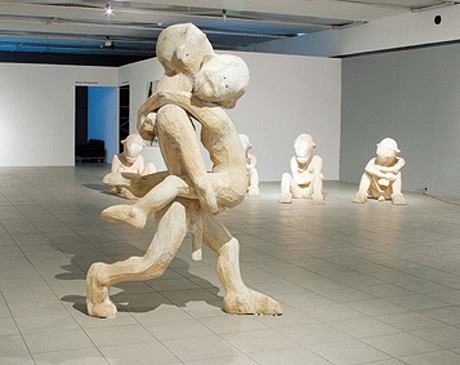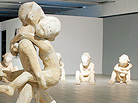W stronę Innego. Obserwacje i interwencje

Artyści:
Paweł Althamer
Sylwester Ambroziak
Małgorzata Jabłońska i Piotr Szewczyk
Anna Konik
Grzegorz Kowalski
Przemysław Kwiek
Jarosław Modzelewski
Zbigniew Libera
Joanna Rajkowska
Grzegorz Sztwiertnia
Jan Świdziński
Jerzy Truszkowski
Krzysztof Wodiczko
Alicja Żebrowska
Artur Żmijewski

W stronę Innego. Obserwacje i interwencje — publikacja Artyści, naukowcy… stale mówimy o człowieku, mówimy o nim w różnej formie, w różnych kolorach, w...

„Nie można zakochać się w słowie. Kochać można tylko człowieka. To jest doskonałość”
Bess w filmie Przełamując fale Larsa von Triera
Wystawa „W stronę Innego. Obserwacje i interwencje” jest kulminacją tematycznych wystaw Biennale Sztuki Wobec Wartości. Pomysł ten sięga do podstawowej idei człowieczeństwa, dialogu, spotkania człowieka z człowiekiem. Z przyjętego u podstaw Biennale motta: „Co jest wymagane, to czyn, który człowiek wykonuje całym jestestwem… Jestem wybrany i wybieram” (Martin Buber), akcentuje jego dynamiczny aspekt.
Projekt „W stronę Innego” rejestruje te obrazy i sfery życia, które wyparte zostały z codziennego, nastawionego na sukces i wieczną młodość, obszaru zjawisk, jak: starość, choroba, bieda, wykluczenie. Z drugiej strony dokumentuje czynne społecznie projekty artystyczne, „wychodzące” w stronę drugiego człowieka i jego problemów.
Zagadnienie „Innego” jest dziś w sztuce, podobnie jak w naukach humanistycznych, mocno eksplorowane. Sama kategoria „Innego” jest ruchoma. Jest nim już nie tylko stary, chory, bezrobotny, emigrant, bezdomny, wykluczony ze względu na płeć… Typ „Innego” będzie za każdym razem, zależnie od kontekstu, oparty o podział na silnych i słabych. A obraz będzie niepełny i fragmentaryczny, ale dzięki temu nie zideologizowany. Przestrzeń sztuki jest być może jednym z ostatnich terenów, gdzie „Inny” nie zostaje wciągany jako alibi dla interesów „posługującej się” nim grupy.
Można dziś powiedzieć, że po dominacji w obrazie sztuki polskiej ostatnich piętnastu lat, kolejno: sztuki krytycznej, pop-banalistycznego malarstwa, sztuki wtapiającej się w codzienną rzeczywistość, na plan pierwszy wychodzi interwencyjna sztuka aktywistyczna. Ona zresztą wywodzi się w naturalny sposób z wymienionych formacji. Duża liczba społecznie interwencyjnych prac pozwala wręcz już mówić o modzie na aktywizm. Powoduje to kolejne wyzwania.
Czy wystawa wykluczonych, „wyautowanych” tematów mimowolnie nie jest sprowadzaniem ich do kolejnego getta, jakim jest dzisiaj obszar sztuki, również wypartej z powszechnego dyskursu? Czy nie należy wobec tego szukać nowych sposobów docierania do odbiorcy oraz faktycznego wpływania na rzeczywistość?
Być może nowym kryterium (w miejsce odkrywczości, autentyczności, formy etc.) dla sztuki, zwłaszcza aktywistycznej, powinno stać się kryterium skuteczności. Podążając za słowami Hansa Haacke, że „w dzisiejszym świecie problemem nie jest zajęcie stanowiska w jakiejś sprawie, problemem jest sprowokowanie publicznej debaty na wybrany temat. Dla wywołania takiej debaty niezbędne jest wsparcie ze strony dziennikarzy i mediów […] Pięć minut w telewizji znaczy dziś więcej niż manifestacja 500 tysięcy osób, której w telewizji nie pokazano”, można by uznać ten przegląd za swego rodzaju podsumowanie etapu, który w ostatnich latach zdaje się kulminować. Etapu, w którym znajdują swe urzeczywistnienie metody ogniskujących: Formy Otwartej i sztuki kontekstualnej.
Wystawa i przygotowywana publikacja „W stronę Innego” obejmuje zarówno klasyczne już prace problemu, jak i nowe projekty. Niektóre powstały w ramach tego projektu. Kuratorski wybór kilkunastu artystów różnych pokoleń daleki jest od ukazania całości zagadnienia.
Przyszłość sztuki aktywistycznej i jej pokrewnych, humanocentrycznych refleksji, spełniać się już będzie być może na innych obszarach. Na terytoriach zajmowanych przez specjalistów od marketingu, programowania, public-relation, telewizji. Nie tylko z wykorzystaniem niektórych ich metod, ale z całkowicie nową sztuką, z wyraźnie modernizującym nastawieniem na skuteczne oddziaływanie wobec rzeczywistości. Jeżeli kiedykolwiek ów nieco utopijny program znajdzie swe ucieleśnienie, będzie miał w artystach zaproszonych do projektu „W stronę Innego” swych istotnych antenatów.
Stanisław Ruksza, kurator wystawy
Patronat medialny:
Katowice, Ultramaryna, Tygodnik Powszechny







